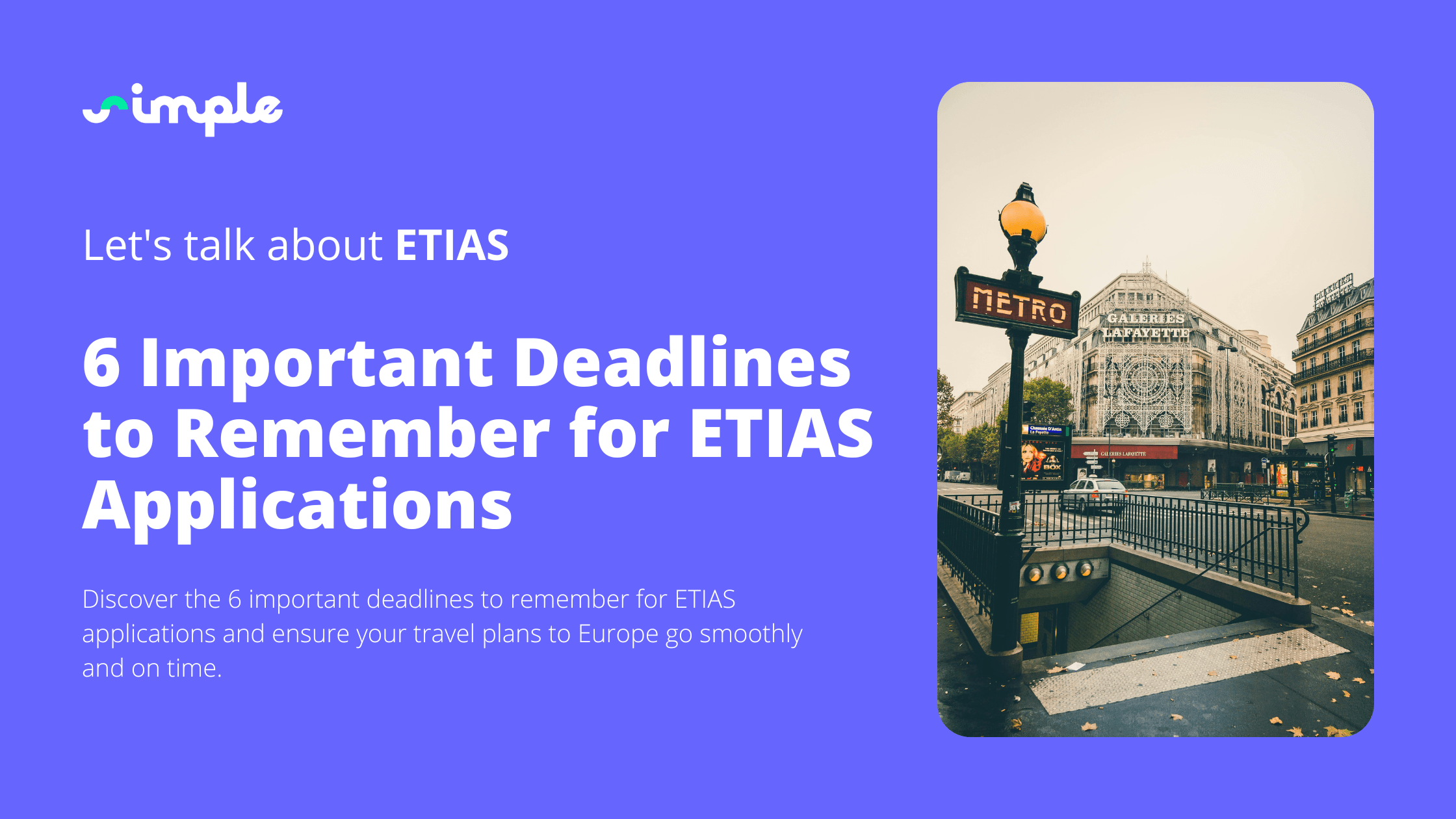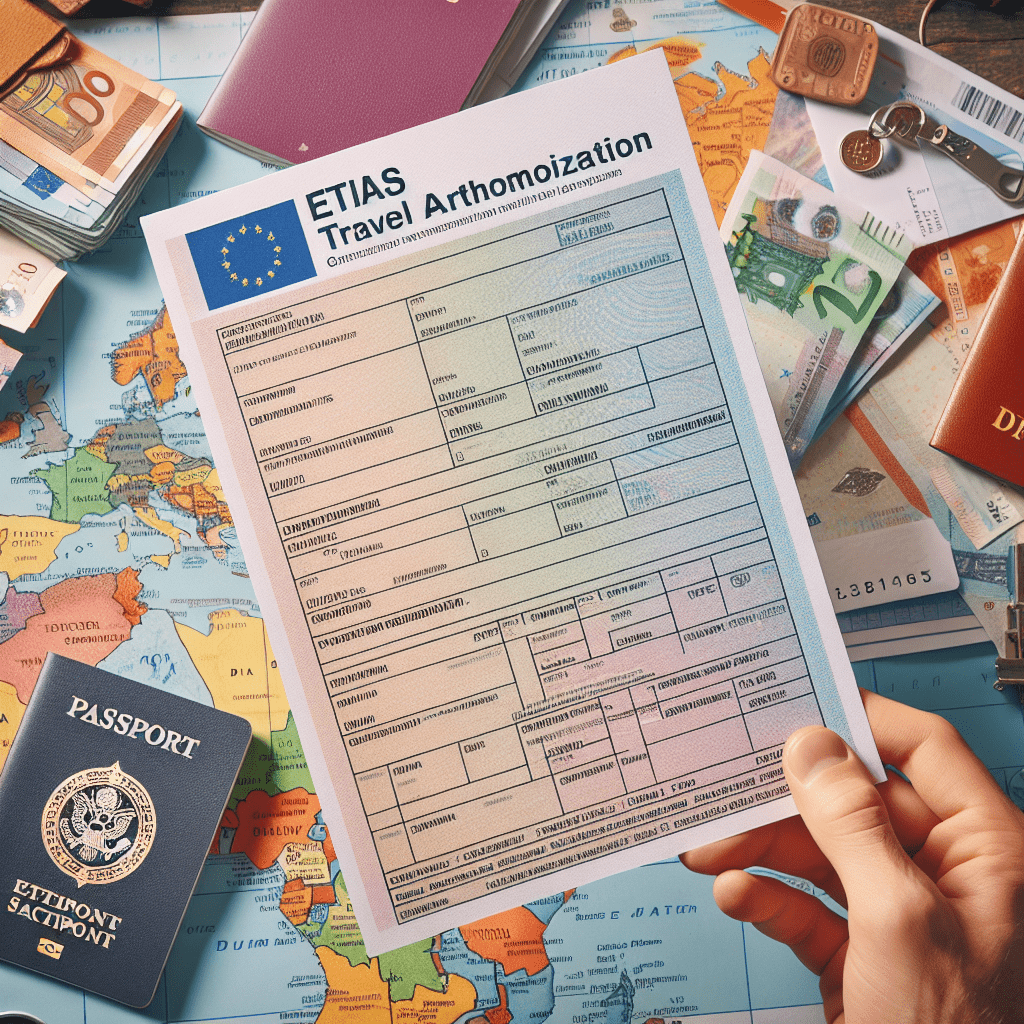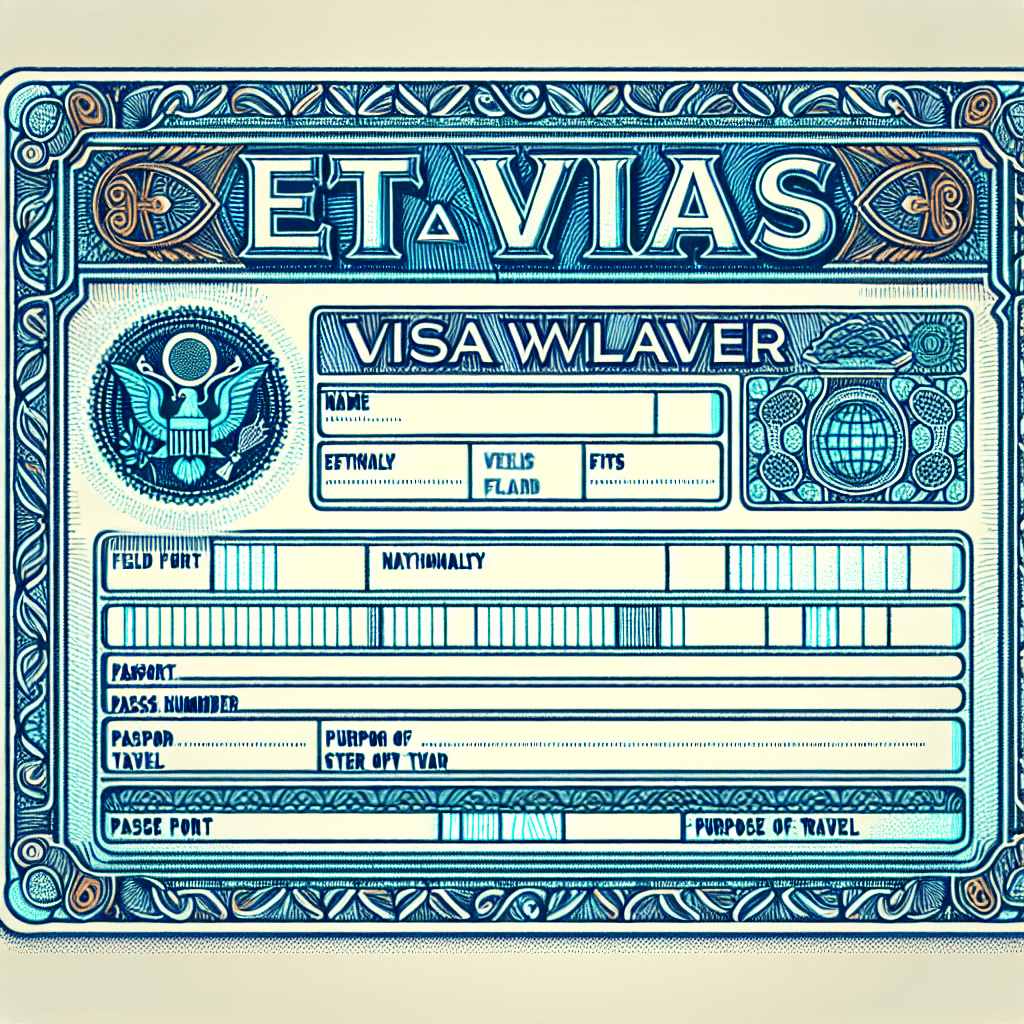6 Important Deadlines to Remember for ETIAS Applications

Traveling to Europe has become more streamlined with the introduction of the ETIAS travel authorization, a new electronic system designed to enhance security and simplify border control for visitors from visa-exempt countries. ETIAS, which stands for European Travel Information and Authorization System, is a mandatory travel permit that travelers must obtain before entering the Schengen Area. This system aims to pre-screen travelers, ensuring safer and more efficient entry while maintaining the freedom of movement across member states.
Understanding the ETIAS application process and its associated deadlines is crucial for anyone planning a trip to Europe. Missing key dates can lead to delays, denied entry, or even the need to reapply, which can disrupt travel plans and cause unnecessary stress. The ETIAS application fee, approval time, and validity period all come with specific timelines that applicants must respect to avoid complications. Whether you are a tourist, business traveler, or visiting family, being aware of these deadlines ensures a smooth and hassle-free experience.
With the ETIAS visa waiver becoming a standard requirement for many travelers, it is essential to stay informed about the critical deadlines involved in the application process. From the moment you decide to apply to the final approval and travel dates, each step has a timeframe that must be followed carefully. This guide highlights six important deadlines that every applicant should remember to guarantee their ETIAS travel permit is processed on time. For more detailed information on ETIAS and how to apply, visit ETIAS.

Understanding the ETIAS Application Timeline
When to submit your ETIAS application
Timing is a critical factor in the ETIAS application process. Although the ETIAS electronic system is designed to be efficient, submitting your ETIAS travel authorization well in advance of your planned trip is highly recommended. Ideally, travelers should apply at least 72 hours before their intended departure to Europe. This timeframe allows the system to perform the necessary security screening and background checks without causing delays. Applying early also provides a buffer in case additional information or documentation is requested during the ETIAS approval time.
While the system is automated and often grants approval quickly, last-minute applications can lead to unnecessary stress and potential travel disruptions. The ETIAS application fee is non-refundable, so rushing the process and risking a denied or delayed ETIAS entry permit is not advisable. For US citizens and other travelers who rely on the ETIAS visa waiver to enter Europe, planning ahead ensures that the travel document is ready and valid before arrival at border control.
Submitting your application too close to your travel date increases the risk of encountering issues that could prevent timely approval. In rare cases, additional security screening may be required, which can extend the ETIAS approval time beyond the standard 72 hours. This makes it essential to avoid last-minute submissions and to monitor your application status regularly. Early application also allows for any necessary corrections or updates to be made without jeopardizing your travel plans.
Validity period of ETIAS authorization
Once approved, the ETIAS travel permit is valid for up to three years or until the expiration of the traveler’s passport, whichever comes first. This extended validity period means that travelers can make multiple trips to Europe without needing to reapply for each visit, provided their travel stays do not exceed 90 days within any 180-day period. Understanding the duration of your ETIAS authorization is crucial for planning repeat travel and ensuring compliance with ETIAS requirements Europe-wide.
Knowing the expiration date of your ETIAS authorization helps avoid situations where a traveler attempts to enter Europe with an expired travel document. Since the ETIAS is electronically linked to your passport, border control authorities will verify its validity upon entry. An expired ETIAS authorization can result in denied entry, even if the traveler holds a valid passport and meets other visa exemption criteria.
For frequent travelers, the validity period also impacts future applications. If your ETIAS authorization expires or your passport is renewed, you must submit a new ETIAS application to obtain a fresh travel permit. Staying aware of these timelines ensures uninterrupted travel and compliance with the ETIAS electronic system’s regulations. It is advisable to keep track of both your passport and ETIAS expiration dates to avoid any last-minute complications.
Timing for corrections or updates post-submission
After submitting your ETIAS application, there is a limited window to make corrections or updates to your information. Since the ETIAS electronic system processes applications quickly, any errors or omissions should be addressed as soon as possible. Common updates might include changes to your travel itinerary, passport details, or contact information. Promptly managing these updates helps maintain the accuracy of your ETIAS travel document and prevents delays in approval.
Delaying corrections or failing to update your application can have serious consequences. If the information provided is inaccurate or outdated, it may trigger additional security screening or even lead to a rejection of your ETIAS entry permit. Inaccurate data can also cause issues at border control, where authorities rely on the information linked to your ETIAS authorization to verify your eligibility for entry.
Best practices for managing your ETIAS application include reviewing all details carefully before submission and monitoring your application status regularly. If you notice any discrepancies or need to update your information, act immediately to notify the relevant authorities or use the official ETIAS platform to make changes. Staying proactive ensures that your ETIAS travel authorization remains valid and that your travel plans proceed without interruption.

Specific Deadlines Related to Travel Plans
Check-in and Boarding Requirements with ETIAS
When preparing for travel to Europe, understanding the check-in and boarding requirements related to your ETIAS travel authorization is essential. Airlines and border control authorities require travelers to present an approved ETIAS travel permit before allowing boarding. This means that having your ETIAS authorization ready and valid well before your departure date is not just a recommendation—it is a strict requirement. Airlines are responsible for verifying that passengers have the necessary ETIAS visa waiver or travel document before permitting them to board flights bound for the Schengen Area.
Check-in deadlines imposed by airlines often require passengers to complete the process several hours before departure. However, the ETIAS electronic system approval must be obtained even earlier to avoid last-minute complications. Presenting an unapproved or expired ETIAS authorization at check-in can result in denied boarding, which can disrupt travel plans and incur additional costs. It is important to remember that ETIAS approval time can vary, especially if additional security screening is required, so applying well in advance is critical.
Non-compliance with ETIAS timelines during travel can lead to serious consequences. Border control officers will verify your ETIAS entry permit upon arrival in Europe, and failure to present a valid authorization can result in refusal of entry. This underscores the importance of aligning your ETIAS application timeline with your travel itinerary. For ETIAS for US citizens and other travelers benefiting from the ETIAS visa exemption, ensuring that the travel document is approved and accessible before check-in is a key step in a smooth travel experience.
Duration of Stay Limits
The ETIAS travel authorization allows visitors to stay in the Schengen Area for a maximum of 90 days within any 180-day period. This duration of stay limit is strictly enforced by ETIAS border control authorities and is a critical deadline for travelers to observe. Overstaying beyond the authorized period can lead to penalties, including fines, deportation, or future travel restrictions within Europe.
Travelers must be aware of the deadlines associated with their exit from the Schengen Area. The 90-day limit is cumulative, meaning that multiple short trips within the 180-day timeframe count toward the total allowed stay. Keeping track of these dates is essential to avoid inadvertently exceeding the permitted duration. The ETIAS travel permit does not grant the right to reside or work in Europe; it is solely for short-term visits such as tourism, business, or family visits.
Penalties for overstaying the authorized period can be severe. In addition to immediate removal from the Schengen Area, travelers may face difficulties obtaining future ETIAS travel authorizations or visas. Border control officers use the ETIAS electronic system to monitor compliance, and overstays are recorded and can impact future travel plans. Understanding and respecting the duration of stay limits is a fundamental part of adhering to ETIAS requirements Europe-wide.
Renewal and Reapplication Deadlines
ETIAS authorizations are valid for up to three years or until the expiration of the traveler’s passport, whichever comes first. Once the ETIAS travel permit expires, travelers must submit a new application to continue visiting Europe under the ETIAS visa waiver program. It is important to be aware of the timeline for submitting a new application to avoid gaps in travel authorization that could disrupt future trips.
Renewal of ETIAS is not a formal process; instead, travelers must complete a fresh ETIAS application. This distinction is important because the ETIAS application process requires providing updated personal and travel information each time. Planning ahead and submitting the new application well before the expiration of the current authorization ensures continuous eligibility to travel without interruption.
For ETIAS for tourists and frequent travelers, managing renewal and reapplication deadlines is a key part of travel planning. Applying too late can result in a lapse in authorization, which may prevent boarding flights or entry at border control. The ETIAS application fee applies to each new application, so timely submission also helps avoid unnecessary additional costs associated with emergency or expedited processing.
In summary, understanding the specific deadlines related to check-in, duration of stay, and renewal is essential for a seamless travel experience. Adhering to these timelines ensures compliance with ETIAS requirements Europe-wide and helps travelers avoid penalties or disruptions. Careful planning and awareness of these deadlines allow travelers to fully benefit from the convenience and security offered by the ETIAS electronic system.

Administrative and Legal Deadlines
Fees and Payment Deadlines
One of the fundamental steps in the ETIAS application process is the payment of the ETIAS application fee. This fee must be paid promptly during the application to ensure that the process moves forward without interruption. The ETIAS electronic system requires payment at the time of submission, and failure to complete this step can result in an incomplete application, which will not be processed. It is essential to understand the timing of this payment to avoid delays in obtaining your ETIAS travel authorization.
Missing or delaying the payment of the ETIAS application fee can have significant consequences. Without payment, the application remains inactive, and the ETIAS approval time cannot begin. This means that even if all other information is correctly submitted, the application will not be reviewed until the fee is paid. For travelers relying on the ETIAS visa waiver to enter Europe, this can lead to last-minute complications, including denied boarding or entry. Airlines and ETIAS border control authorities strictly enforce these requirements, making timely payment a critical deadline to observe.
To ensure payment completion on time, applicants should use reliable payment methods accepted by the ETIAS platform, such as credit or debit cards. It is advisable to verify that the payment has been successfully processed and to keep a record of the transaction. Additionally, applicants should avoid submitting applications during peak travel seasons without allowing extra time for payment processing and approval. Being proactive about the ETIAS application fee helps maintain a smooth and efficient application process.
Data Privacy and Record Updates
During the ETIAS application process, applicants may be requested to submit additional documents or information to verify their eligibility or clarify details. These requests come with strict deadlines that must be met to avoid delays or rejection of the ETIAS travel permit. Timely submission of requested documents is crucial for maintaining compliance with ETIAS requirements Europe-wide and ensuring that the application proceeds without unnecessary interruptions.
Responding promptly to inquiries from ETIAS authorities is equally important. The ETIAS electronic system is designed to perform thorough security screening, and any gaps or inconsistencies in the data provided can trigger further investigation. Delays in providing additional information can extend the ETIAS approval time significantly, potentially jeopardizing travel plans. For ETIAS for US citizens and other travelers, staying attentive to communication from ETIAS authorities helps prevent avoidable complications.
Data privacy is a key consideration throughout the application process. Applicants should ensure that all submitted information is accurate and up to date, as inaccuracies can lead to security screening issues or application denial. Maintaining clear and timely communication with ETIAS authorities demonstrates compliance and facilitates a smoother approval process. Ultimately, meeting deadlines related to data privacy and record updates is essential for securing a valid ETIAS travel document.
Compliance with New or Changing ETIAS Regulations
The regulatory landscape surrounding ETIAS is subject to change as European authorities refine security measures and travel policies. Applicants must stay informed about any updates to ETIAS requirements Europe-wide to ensure ongoing compliance. Authorities typically notify applicants of regulatory changes and associated deadlines through official channels, emphasizing the importance of monitoring these communications closely.
Adjusting applications based on policy changes may involve submitting additional information, updating existing data, or even reapplying if new eligibility criteria are introduced. Staying proactive in responding to these changes helps applicants avoid lapses in their ETIAS travel authorization. For ETIAS for tourists and frequent travelers, understanding how evolving regulations impact the application process is vital for uninterrupted travel.
Meeting deadlines related to regulatory updates is not only a matter of administrative compliance but also a legal obligation. Failure to adhere to new requirements can result in invalidation of the ETIAS travel permit or denial of entry at border control. The ETIAS electronic system is designed to integrate these updates seamlessly, but applicants must cooperate by providing timely responses and adjustments. Staying informed and compliant with changing ETIAS regulations ensures that travelers maintain their eligibility for the ETIAS visa waiver and enjoy a secure, hassle-free journey to Europe.

Planning Ahead for Seamless ETIAS Travel Authorization
Proactive planning around ETIAS deadlines is essential for anyone intending to travel to Europe under the new ETIAS visa waiver system. The ETIAS travel authorization is a critical document that streamlines entry into the Schengen Area, but it comes with specific timelines and requirements that must be carefully observed. By understanding and respecting these deadlines—from application submission and payment of the ETIAS application fee to managing validity periods and responding promptly to requests for additional information—travelers can avoid unnecessary delays and complications. This foresight not only ensures compliance with ETIAS requirements Europe-wide but also contributes to a smoother, more predictable travel experience.
Travelers who take the time to familiarize themselves with the ETIAS application process and its associated deadlines reduce the risk of last-minute issues such as denied boarding or refusal of entry at ETIAS border control points. The ETIAS electronic system is designed to facilitate quick and secure processing, but it relies on applicants meeting all deadlines and providing accurate information. For ETIAS for US citizens and other eligible travelers, this means that early application and careful attention to timelines are not optional but necessary steps to guarantee a valid ETIAS travel permit before departure.
In addition to preventing travel disruptions, proactive planning around ETIAS deadlines helps travelers manage their itineraries more effectively. Knowing the validity period of the ETIAS authorization and the maximum duration of stay allows for better scheduling of trips and avoids penalties associated with overstaying. Furthermore, understanding renewal and reapplication deadlines ensures continuous eligibility for travel without gaps that could complicate future visits. Overall, a well-organized approach to ETIAS deadlines supports both compliance and convenience, making international travel to Europe more accessible and less stressful.
Using the outlined deadlines as a checklist is a practical way to maintain compliance and avoid travel disruptions. By systematically tracking key dates—such as when to submit the ETIAS application, when to pay the application fee, and when to renew the authorization—travelers can stay ahead of potential issues. This checklist approach also encourages timely responses to any requests for additional documentation or updates, which are crucial for the ETIAS approval time and final issuance of the ETIAS travel document.
Adopting this methodical mindset benefits not only first-time applicants but also frequent travelers who rely on the ETIAS visa waiver for multiple trips. Staying informed about changes in ETIAS requirements Europe-wide and adjusting applications accordingly further enhances compliance and reduces the risk of unexpected complications. Ultimately, treating ETIAS deadlines as integral milestones in travel planning empowers travelers to enjoy the freedom and security that the ETIAS system is designed to provide, ensuring a hassle-free journey to Europe every time.